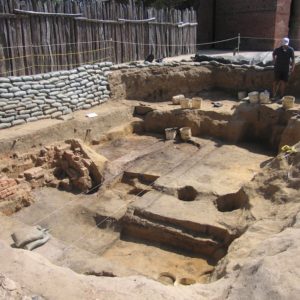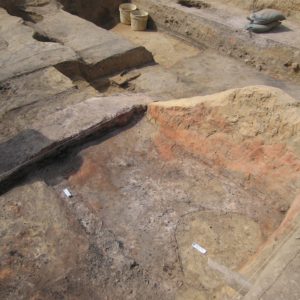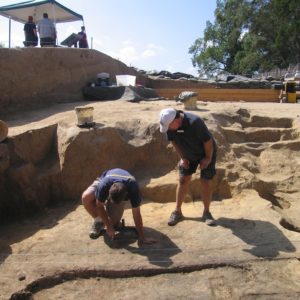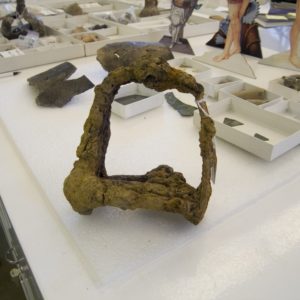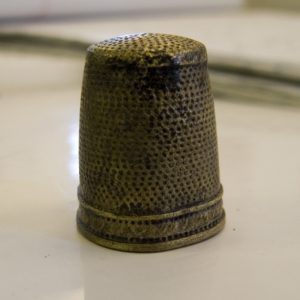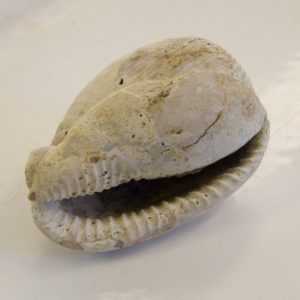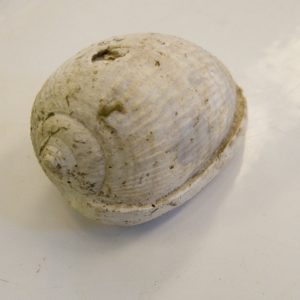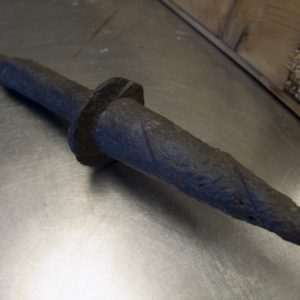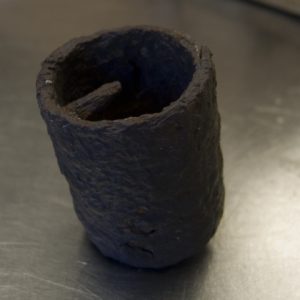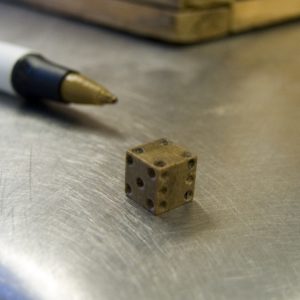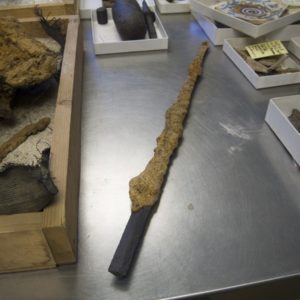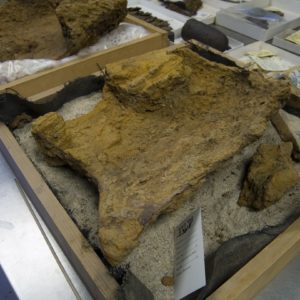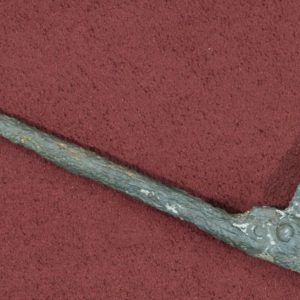 Digging in a cellar that dates to the earliest years of James Fort, Jamestown Rediscovery archaeologists have uncovered a layer of ash that covers a large portion of the cellar’s floor. One section of the cellar’s clay walls has turned red due to close proximity to an intense heat source. Also, the outline of a hearth can be clearly seen on the ground adjacent to this wall. It is obvious that the colonists were creating fires in this cellar, but it is not so obvious yet what the fires’ purpose was or how the ash came to be spread over such a large portion of the cellar’s floor. In their excavations intended to answer these questions and piece together a rather confusing floor plan for the cellar, archaeologists have discovered a myriad of 16th- and 17th-century artifacts, including breastplates, coins, and even a sword blade.
Digging in a cellar that dates to the earliest years of James Fort, Jamestown Rediscovery archaeologists have uncovered a layer of ash that covers a large portion of the cellar’s floor. One section of the cellar’s clay walls has turned red due to close proximity to an intense heat source. Also, the outline of a hearth can be clearly seen on the ground adjacent to this wall. It is obvious that the colonists were creating fires in this cellar, but it is not so obvious yet what the fires’ purpose was or how the ash came to be spread over such a large portion of the cellar’s floor. In their excavations intended to answer these questions and piece together a rather confusing floor plan for the cellar, archaeologists have discovered a myriad of 16th- and 17th-century artifacts, including breastplates, coins, and even a sword blade.
Excavations in the cellar—located near the northern bulwark of James Fort, parallel to the eastern wall—began in the spring. Early artifacts began to turn up almost immediately, but only recently have the archaeologists begun to reach the lowest levels of the cellar and thereby gain a more complete picture of the feature’s form and function. Though they are learning more about the layout of the cellar, at this point the archaeologists are left with more questions than they have answers. There seem to be several phases of construction on the cellar. One section of the floor, directly below the earthen stairs found in August, seems to have been raised up by adding more clay to its base layers. Several postholes, some of them a foot or more in diameter, are evidence of supports for what was probably a fairly-substantial structure overhead. The outline of a hearth is clearly visible, one side of which is bounded by a clay wall that has been turned a deep read and hardened by the fires that were burned there.
Then there is the question of the ash that covers much of the floor of the cellar, including areas that are not in close proximity to the hearth itself. Is this evidence for a fire that started in the hearth but got out of control and spread to consume the cellar and the building above? Did the chimney collapse and fill the cellar with a thick cloud of ash? Is this ash a record of one of the fort-wide fires that plagued the colony throughout its existence? Or was this simply the result of years of use, with errant ash being spread as it was being collected to heat cooking devices such as pipkins elsewhere in the fort? There is hope that further excavations will shed more light on the origin of the ash, and on the nature of the cellar itself.
While there is still much to learn about this early feature, the excavations conducted to define it have uncovered a large and varied assortment of artifacts from around the turn of the 17th century and earlier. This has been the case since the beginning of the cellar’s excavation, when several sword hilts and a nearly-complete broadsword were found in May. Within the past month, several iron breastplates have been found as well as a 20-inch segment of a rapier blade and several Scottish sword pommels. A reticulated cowrie helmet, the shell from a mollusk found in tropical waters such as the Caribbean and those surrounding Bermuda, was found in the cellar, probably serving only as a keepsake. The shell has become white with age but was once naturally brilliantly colored. A timber scribe or race knife, a device used to mark etchings into wood, was also found in the cellar. These devices were used by shipbuilders and carpenters who marked timbers designed to fit into one another at a time before pre-fabricated wood and one-size-fits-all uniformity of building materials. These matching marks were useful because the timber was often prepared and fitted together, marked and then taken apart again for transport to the building or ship being built.
A tiny bone die, its discreet size perhaps making it easier to hide at a time when gaming was frowned-upon or even illegal, was recently excavated from the cellar. It joins a number of other similarly-sized dice in the Historic Jamestowne collection. An iron bung auger designed to drill holes in barrels was found in the cellar. The rust on the auger has been completely removed by the Jamestown Rediscovery conservation team and the threaded surface of the drill end is clearly visible. A beautifully-preserved copper-alloy thimble discovered in the cellar still retains its serpent-like maker’s mark just above its banded base. Finally, a heavily-rusted stirrup found in the cellar is known to be very old due to the fact that it is so large and heavy. This more substantial type of stirrup was a design meant to support the weight of an armored knight, his legs fully extended. As cavalrymen began to wear less armor, stirrups had to bear less weight and became less substantial in size and heft.
The Jamestown Rediscovery archaeological team plans on continuing to concentrate their efforts on the cellar over the coming weeks. Once they have learned all they can from the feature, the plan is to head toward the center of the fort in the hopes of finding the original church.
related images
- View of the cellar
- View of the cellar
- David Givens and Dan Smith in the cellar
- 16th-century Spanish coin
- Heavily-rusted stirrup
- Copper alloy thimble
- Reticulated cowrie helmet
- Another view of the reticulated cowrie helmet
- Bung auger used to drill holes in wooden barrels or casks
- Ground iron, the bottom piece for a wooden staff
- Bone die found in the cellar
- Partially-conserved rapier blade fragment
- Armor breastplate
- Race knife or timber scribe



